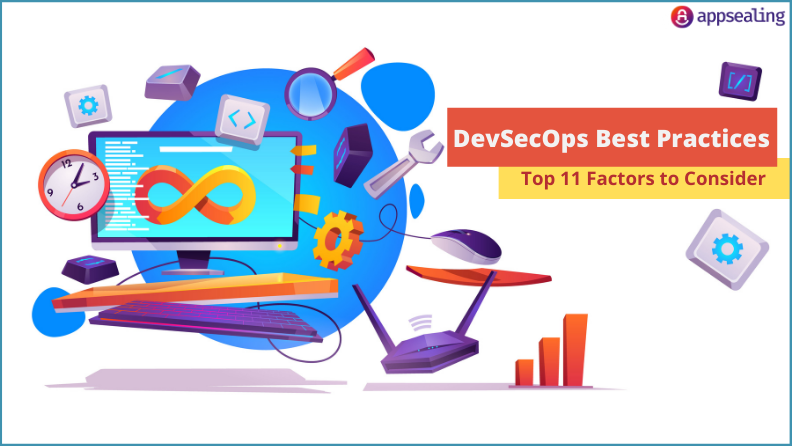DevSecOps integrates security into DevOps practices and helps identify and flag security issues early on. It doesn’t wait till a product is released. All the relevant stages – development, testing, issue fixing, go-live – take security into consideration. This ensures that security issues aren’t pushed till the last stage of the software development lifecycle. In a rapidly insecure and emerging world, this method works the best as teams can focus on quality and not chase deadlines alone to accomplish their development goals. Identifying issues is seamless, fixing gaps is faster and the costs for ensuring security are lowered. Security bottlenecks are reduced, compliance is increased, and security vulnerabilities are minimized. That said, some DevSecOps best practices do come in handy when implementing DevSecOps in SDLC.
DevSecOps Best Practices
Start Slow and Plan Optimally
Any change will be extremely difficult to implement when multiple stakeholders are involved. DevSecOps is a methodology which might not get a go-ahead immediately. All teams will have their own goals, and everybody would be (understandably) chasing deadlines. But having realistic security goals is important and helpful. Development, operations, testing and security teams have to really come together to identify and fix possible security loopholes.
Train and Educate Team Members
It would be good to educate your teams about how security is not just the job of the core security team. Emphasizing that it is a shared responsibility will help in ensuring that the methodology is understood and imbibed by team members. Having security champions can help address security concerns in a focused manner by taking tough, required decisions.
Have the Right Mix of Teams
Setting up different teams (red teams for external ethical hacking, blue teams for internally responding to incidents and hacks conducted by the red teams, bug bounty program for recognizing and rewarding team members who report vulnerabilities) is a smart thing to do and highly recommended.
Develop a Security Culture
A focused approach of people > process > technology can help get the seriousness expected. Top management buy-in would be a good starting point too. When goals and objectives are set by everyone, security becomes second nature. Also, providing rules and SLAs for issue resolution will help teams take security seriously. In short, a security mindset is paramount.
Practice, Practice, Practice
Practice does make one perfect. DevSecOps is not a one-time activity and every project will provide key learnings. Miscommunication or bottlenecks can be resolved as teams come across similar scenarios. Practices can be enhanced as one moves from one project to another.
Manage Incidents
Since security will now be a key focus, a dedicated incident management/issue fixing plan will go a long way in ensuring that issues are fixed in a phased out, planned manner. This is where workflows, defined responsibilities and action plans can help.
Develop Simple yet Secure Coding Practices
As codes get developed, proper verification and testing are crucial. Implementing robust coding practices to cover security in advance also makes tasks easier for everyone. Simple coding practices will enable developers to debug the code and enhance it further. Other developers and testers will also be able to work on the code and testing activities smoothly.
Develop Internal Standards of Coding and Change Management
Following coding best practices is important, but developing internal standards and training processes will help add further flavours of security. This also involves creating better change management processes and running the application through security checks regularly.
Lean on Robust Audits
Internal as well as external audits are what we are talking about here. Understanding the risk exposure and the readiness of the systems to combat the risks are covered well through such audits. An audit once in a year would be good to have to also check the progression of security plans from a DevSecOps perspective.
Test Vigorously
Testing the code and application across the entire lifecycle will help uncover issues before they snowball into larger problems. Live testing, analyzing input parameters, fine tuning process flows etc. are all important factors. Automation testing can also come in handy to test third-party dependencies and open-source applications. This becomes relevant in the current times when applications are interacting with each other and the outside world.
Leverage Automation and Tools Smartly
Meeting deadlines is not that difficult, thanks to automation. Security need not create bottlenecks every time as automation and tools make it super easy to test and deploy applications. Static application security testing (SAST) can help scan certain code changes whereas Dynamic application security testing (DAST) can help test an application during runtime. Customizing alerts, setting thresholds, and leveraging rich reports also enable teams to understand how processes can be improved. Providing training to teams for the various tools will help in not just ensuring smooth issue resolution but will also enable them to upskill along the way.
Future of DevSecOps
Shifting security a bit on the left is really the need of the hour as issue fixing tends to become easier and a lot cheaper when security is given due importance. Going forward, teams will be expected to deliver on time. In fact, companies can expect deadlines to be stricter. The key lies in bringing together people, process and technology to ensure that every team imbibes the culture of security and leverages technology to be on top of their game – both from a development and a security perspective. DevSecOps will also usher in the era of moving development and operations to the cloud for a more seamless experience. Continuous Integration (CI) frameworks will also help to automate security checks. Companies will also set up KPIs to be measured, tracked and improved.
AppSealing to the rescue:
The speed at which applications are getting developed is unprecedented. But managing security towards the end or ticking the checkboxes of security when the development is completed and the product is ready to be released tomorrow will do more harm than good. At AppSealing, we understand that security can sometimes be difficult to manage. Our solutions are thus developed to ensure that you take care of security in the most seamless fashion with the least effort. This is where our zero-coding application security solution comes in. We provide round-the-clock threat analytics, so you can focus on developing great applications. If this sounds exciting, give us a buzz and we would be happy to assist you in taking a zero-coding yet proactive security approach to mobile application security.
Frequently Asked Questions
1. What are DevSecOps practices?
Here are some DevSecOps best practices:
- Threat modeling: Helps identify potential vulnerabilities before they arise during development
- Security automation: Can be integrated into the CI/CD pipeline to validate security for every released code
- Vulnerability scanning: Checks code for vulnerabilities at every stage of delivery
- Security policies: Establish clear policies and procedures for access control, configuration management, code reviews, vulnerability testing, and security tools
- DevSecOps culture: Cross-functional teams share a common goal of consistent application security
- Secure infrastructure: Security testing is conducted throughout the development process
- Infrastructure as code: Allows for infrastructure provisioning and management
- Automate: Reduces human error, streamlines processes, and improves efficiency
2. What are the key principles of DevSecOps?
Here are some other principles of DevSecOps:
- Reducing risk: Focus on risk awareness and create a plan to integrate security early and often
- Culture: Create a collaborative organization with a safe environment and inclusion
- Continuous monitoring: Ensure the security of software development processes
- Risk assessment: Protect applications and systems
- Automated testing: Use automated testing wherever possible
- Compliance: Ensure continuous compliance
- Threat preparation: Invest in advanced training for engineers and be prepared for threats
3. How to improve DevSecOps?
There are several key ways to improve your DevSecOps practices:
- Shift security left: Integrate security testing into the early stages of development, rather than waiting until the end.
- Automate security testing: Use tools to automate security checks throughout the development pipeline.
- Promote collaboration and communication: Break down silos between development, security, and operations teams.
- Use the right tools: Invest in DevSecOps tools that integrate with your existing workflow and provide valuable feedback.
- Focus on continuous monitoring: Continuously monitor your applications for security threats.
- Build a security culture: Make security a priority for everyone by training staff on best practices.
4. How to setup DevSecOps?
Setting up DevSecOps isn’t a one-step process, but rather a cultural and operational shift. Here’s a breakdown to get you started:
- Foundational Shift:
- Culture
- Planning
- Tooling and Automation:
- Security Scanning
- CI/CD Pipeline
- Security Champions
- Continuous Monitoring and Improvement:
- Security Monitoring
- Feedback Loop
Focus on high-impact areas first and tailor your approach to your specific needs. There are many resources available online and from AppSealing to help you on your DevSecOps Best Practices.
5. What is DevSecOps’ strategy?
DevSecOps’ strategy revolves around integrating security throughout the entire software development lifecycle (SDLC), not as an afterthought. This means:
- Shifting left: Security testing happens early in development, allowing for quicker fixes.
- Shared responsibility: Security becomes everyone’s concern, not just the security team.
- Automation: Security checks are automated within the development pipeline.
- Continuous monitoring: Applications are constantly monitored for vulnerabilities.
Cultural shift: Collaboration and communication are key between development, security, and operations teams.






